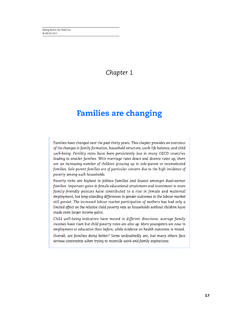Transcription of The Future of Families to 2030 The Future of Families to 2030
1 The Future of Families to 2030A SYNTHESIS Future of Families to 2030A SYNTHESIS REPORTINTERNATIONAL FUTURES PROGRAMME Contacts: Barrie Stevens at Pierre-Alain Schieb at Anita Gibson at OECD 2011 Applications for permission to reproduce or translate all or part of this document should be made to OECD Publications, 2 rue Andr Pascal, 75775 Paris, Cedex 16, France. E-mail: THE Future OF Families TO 2030 PROJECTIONS, policy CHALLENGES AND policy OPTIONSA Synthesis ReportInternatIonal Futures programmeORGANISATION FOR ECONOMIC CO-OPERATION AND DEVELOPMENTThe OECD is a unique forum where governments work together to address the economic, social and environmental challenges of globalisation. The OECD is also at the forefront of efforts to understand and to help governments respond to new developments and concerns, such as corporate governance, the information economy and the challenges of an ageing population.
2 The Organisation provides a setting where governments can compare policy experiences, seek answers to common problems, identify good practice and work to co-ordinate domestic and international OECD member countries are: Australia, Austria, Belgium, Canada, Chile, the Czech Republic, Denmark, Estonia, Finland, France, Germany, Greece, Hungary, Iceland, Ireland, Israel, Italy, Japan, Korea, Luxembourg, Mexico, the Netherlands, New Zealand, Norway, Poland, Portugal, the Slovak Republic, Slovenia, Spain, Sweden, Switzerland, Turkey, the United Kingdom and the United States. The European Union takes part in the work of the Publishing disseminates widely the results of the Organisation s statistics gathering and research on economic, social and environmental issues, as well as the conventions, guidelines and standards agreed by its INTERNATIONAL FUTURES PROGRAMME - OECD 2011 TABLE OF CONTENTST able of ContentsForeword.
3 51. Introduction 2. Future changes in family and household composition Linking household and family structures to wider social 8 Projecting changes in household structures to 2025-30 .. 93. Factors shaping the family landscape to 2030 Demographic changes .. 14 Society and social 18 Technology .. 21 The economic outlook .. 254. Using stylised scenarios to explore alternative futures The Golden Age? scenario .. 28 The Back to Basics scenario .. 305. policy challenges and policy options Taking the long view .. 34 Annex Steering Group members, experts and observers .. 435 INTERNATIONAL FUTURES PROGRAMME - OECD 2011 FOREwORDF orewordThe OECD International Futures Programme (IFP) launched its project on Families to 2030 in December 2009. Its aim was to identify and examine trends in household and family structures over the next two decades and to explore the implications of those trends for key policy areas.
4 This was by nature an experimental project, since very little international work had been conducted at the time on the theme of the Future of Families . It was an opportunity to apply foresight tools to a new, relatively unexplored subject area. The project was designed, co-ordinated and conducted by the IFP team, assisted by several external experts in the social policy field. Funding, advice and guidance were provided by a Steering Group composed of representatives from several different ministries (Education, Family, Economic Affairs, Social Affairs, Communities and Local Government Affairs) from the countries participating in the project in various capacities, and including support from the Russell Sage Foundation (USA). Additional input was provided by colleagues from various OECD departments, and by a number of other countries who attended the final the purposes of the project, the interpretation of the notion of family was a broad one, since several generations had to be taken into account to reflect participants interest in intergenera-tional matters, such as solidarity, transfers and values.
5 It needed to encompass young couples with children, young couples with no children, single-parent Families , couples whose children have left home, and elderly family members. Consideration also had to be given to the evolving structure of modern Families that has emerged from recent trends in divorce, second marriages and co-habitation, same-sex partnerships, and reconstituted Families . The IFP team structured the project in successive modules, and drafted two preliminary reports following a stocktaking exercise on the current state of play of family-related developments and policies in OECD countries. The drafts examined factors shaping the family landscape in OECD countries to 2030, and the outlook for family and household structures to the period 2025-2030. A workshop for participants was convened at which four scenarios later merged into two were developed and explored.
6 At the same time, three in-depth work streams were started by external experts on themes agreed by the Steering Group: the Future of work-family life balance (Jeanne Fagnani), the Future role of the elderly in the family (Klaus Haberkern and colleagues), and the Future of low-income Families and social cohesion (Susan Harkness). The authors sought to take into consideration the long-term trends affecting Families and the two scenarios engendered at the workshop in setting out the policy challenges and policy options in their respective field. A final task for the IFP team consisted in drawing cross-cutting policy conclusions from all three project was directed by Barrie Stevens and Pierre-Alain Schieb. Anna di Mattia provided research assistance; Anita Gibson and Rossella Iannizzotto provided logistics support and Gillian O Meara edited the text.
7 The Steering Group was chaired by Michael Oborne and Barrie overview contains a synthesis of some of the key findings of the project. The full report is published as The Future of Families to 2030 .6 INTERNATIONAL FUTURES PROGRAMME - OECD 2011 THE Future OF Families TO 2030 Ten long-term policy options As many OECD governments will find it hard to sustain current levels of universal social benefit coverage over the next two decades, they need to prepare the ground for reforms well in advance. This should be done by:Ensuring they have long-term fiscal projections and scenarios of Future public spending on health, longterm care, pensions and social benefits, and by exploring the scope for achieving value for money through more effective broad avenues for improving social outcomes without increasing spending, through a re-balancing of responsibilities among individuals, the family, business, associations and the state.
8 This can be achieved by: reviewing family responsibilities and entitlements within the broader scope of the so-called family network ; re-visiting the issue of responsibility and individual choice; and enlarging the con-tribution that greater engagement of all social actors can savings, or at least more efficient outcomes, through more coherent policy approaches, for example by looking at individuals planning, financing and organi-sation of care in terms of overall life-cycle as a priority the need to move individuals and Families out of poten-tially long-term dysfunctional situations, such as long-term unemployment, chronic poverty, and young people in neither employment, nor education nor more weight to the potential uses of new technologies in addressing some of the structural problems that may affect Families in the Future .
9 And to the possibilities for integrating technological innovations into policy considerations and more attention to Future shifts in the spatial mobility patterns of households and Families , as mobility will become increasingly important for maintaining family greater use of the scope offered by housing policies to influence family formation and intergenerational sustained efforts to step up gender mainstreaming with a view to limiting the long-term detrimental effects of perpetuating gender the evidence base for effective policy -making through concerted efforts to close data and research gaps, notably in the fields of long-term projections, longitudinal household panels, and the growing phenomenon of reconstituted the links among family-relevant aspects of different policy domains, such as care for children and the elderly, labour market, education, technology and housing.
10 7 INTERNATIONAL FUTURES PROGRAMME - OECD 2011 THE Future OF Families TO 20301. IntroductionSince the 1960s the family in the OECD area has undergone significant transformation. In many countries, the extended family has all but disappeared, and the traditional family consisting of a married couple with children has become much less widespread as divorce rates, cohabitation, couples living together apart , single parenthood and same-sex partnerships have all increased. with rising migration, cultures and values have become more diverse. Families have seen more mothers take up work in the labour market (and many of them earn more than their male partners). Adolescents spend longer and longer in education and training, and the elderly members of the family live longer and, increasingly, alone. The repercussions of these changes on housing, pensions, health and long-term care, labour markets, education and public finances, have been Better for Families (OECD, 2011a) tracks these and other societal changes that have occurred over the last few decades.












